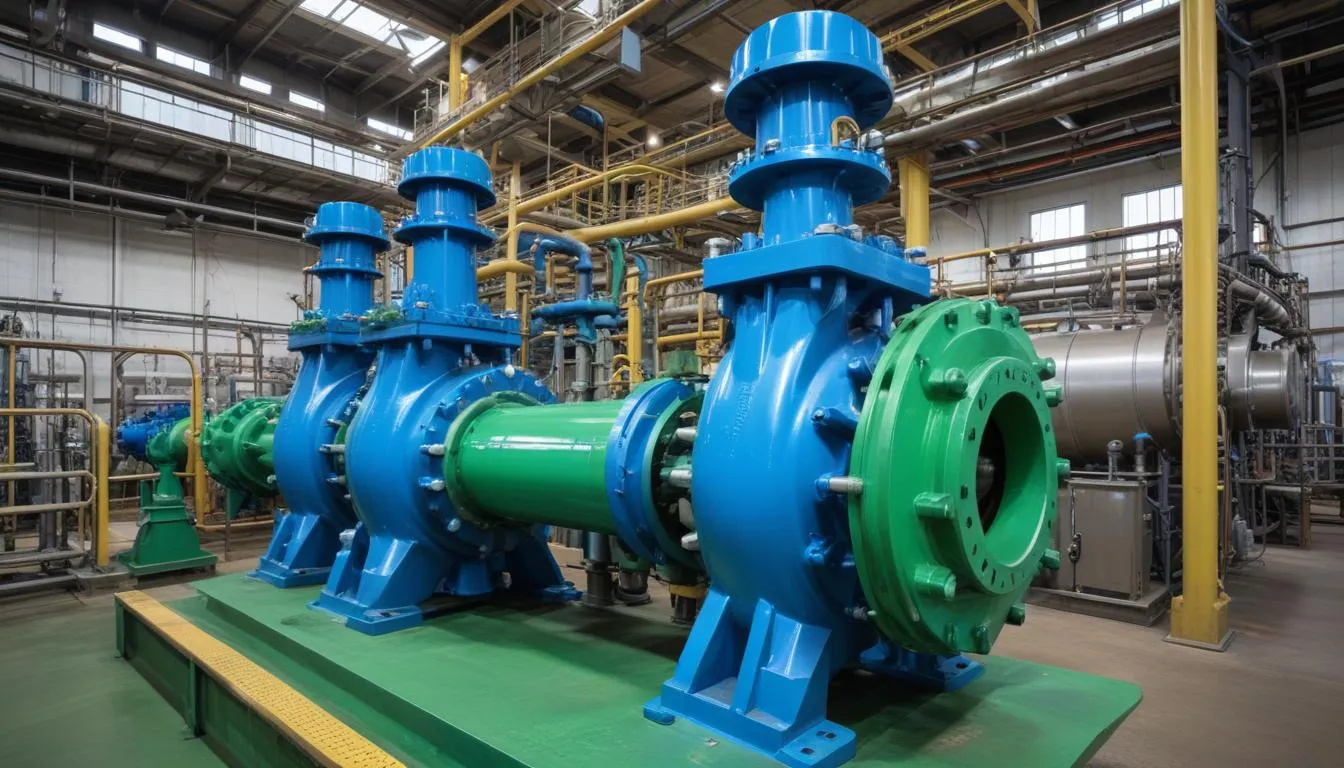 In chemical plants, the efficiency of pumps is crucial for optimizing performance and ensuring energy savings. Pump efficiency is defined as the ratio of the hydraulic power delivered by the pump to the mechanical power consumed by it. This ratio is typically expressed as a percentage, providing a clear indication of how effectively a pump converts input energy into hydraulic energy.
In chemical plants, the efficiency of pumps is crucial for optimizing performance and ensuring energy savings. Pump efficiency is defined as the ratio of the hydraulic power delivered by the pump to the mechanical power consumed by it. This ratio is typically expressed as a percentage, providing a clear indication of how effectively a pump converts input energy into hydraulic energy.
The efficiency of chemical plant pumps can vary significantly based on several factors, including design, operating conditions, and maintenance practices. A high-efficiency pump can lead to lower operational costs and reduced emissions, making it essential for chemical manufacturers to focus on this aspect.
Several key aspects contribute to understanding the overall efficiencies of pumps:
- Hydraulic Efficiency: This pertains to the pump’s ability to convert mechanical energy into hydraulic energy.
- Volumetric Efficiency: This measures the pump’s ability to move fluid without leakage, indicating how much of the fluid is pumped relative to the volume drawn in.
- Mechanical Efficiency: This reflects the losses due to friction in the pump components, including bearings and seals.
To evaluate pump efficiencies accurately, the following metrics should be monitored:
| Efficiency Type | Description | Importance |
|---|---|---|
| Hydraulic Efficiency | The effectiveness of fluid movement from inlet to discharge. | Critical for operational effectiveness and energy costs. |
| Volumetric Efficiency | The percentage ratio of actual flow to the theoretical flow. | Indicates the degree of leakage in the system. |
| Mechanical Efficiency | The measure of energy loss due to friction and mechanical parts. | Affects overall energy consumption and operational lifespan. |
Monitoring the efficiency of pumps not only helps in identifying issues but also aids in enhancing operational performance, thereby maximizing productivity in chemical plants. Regular assessments and adjustments can significantly enhance pump performance and ensure that energy resources are utilized efficiently.
Types of Pumps Used in Chemical Plants
In chemical plants, various types of pumps are utilized to meet the demands of different processes and fluids. Understanding the specific functions and characteristics of these pumps is essential for optimizing performance and maximizing efficiency. Below are the primary types of pumps commonly used in chemical processing:
- Centrifugal Pumps: These pumps operate using a rotating impeller to impart kinetic energy to the fluid, converting it into hydraulic energy. They are widely favored for their ability to handle large flow rates and are suitable for transporting low-viscosity liquids. Centrifugal pumps exhibit high efficiency and are ideal for continuous operation in various chemical processes.
- Positive Displacement Pumps: Unlike centrifugal pumps, positive displacement pumps move fluid by trapping a fixed amount and forcing it into the discharge line. They are highly efficient at moving high-viscosity fluids and are known for their ability to maintain consistent flow rates regardless of pressure variations. This type includes gear pumps, diaphragm pumps, and screw pumps, which are tailored to specific applications and fluid characteristics.
- Diaphragm Pumps: A subtype of positive displacement pumps, diaphragm pumps are great for handling corrosive and abrasive liquids. They utilize a diaphragm, which flexes to create a vacuum that draws fluid into the pump. This design minimizes leakage, enhancing volumetric efficiency.
- Submersible Pumps: These pumps are designed to operate while fully submerged in the fluid being pumped. They are commonly used in applications requiring the removal of water or liquids from tight spaces, such as pits or basins, and are known for their compact design and high efficiency in specific settings.
- Gear Pumps: These positive displacement pumps rely on gears to move fluid. As the gears turn, they create a vacuum that draws fluid into the pump, which is then transferred through the discharge. Gear pumps are efficient for transferring viscous materials and provide precise volumetric flow rates.
Choosing the right type of pump is critical in ensuring not only operational efficiency but also the longevity of the equipment and safety in chemical processing. Each pump type has its unique advantages and is chosen based on factors such as the properties of the fluid being pumped, required flow rates, and the specific applications involved. Regular evaluation of pump performance is vital to enhance operational efficiency and reduce energy consumption in chemical plants.
Factors Affecting Pump Performance
Several elements significantly influence the performance of chemical plant pumps, each affecting their overall efficiency. Understanding these factors allows operators to optimize pump usage and enhance system performance.
- Fluid Properties: The characteristics of the liquid being pumped, including viscosity, density, and temperature, play a pivotal role in pump performance. High-viscosity fluids demand more energy and can lead to increased wear on pump components, reducing efficiency over time.
- Pump Design and Technology: The design of the pump, including impeller type and geometry, directly impacts how efficiently it can operate under various conditions. Advanced designs often incorporate features that reduce turbulence and hydraulic losses, enhancing performance.
- Operating Conditions: Conditions such as flow rates, pressure levels, and temperature variations can affect pump efficiency. Pumps operating outside their recommended ranges are likely to experience a decline in performance, leading to increased energy consumption and potential mechanical failure.
- Installation and Positioning: Proper installation is crucial for optimal operation. Issues such as incorrect alignment, inadequate support, and improper positioning can introduce mechanical stress and lead to vibrations, which diminish efficiency and longevity.
- Maintenance Practices: Regular maintenance is essential in preserving pump performance. Over time, wear and tear can lead to inefficiencies due to factors such as seal degradation, clogged filters, or bearing failures. Implementing a proactive maintenance schedule can mitigate these issues, ensuring that the pump operates at peak efficiency.
In practice, the relationship between these factors can be illustrated by monitoring specific performance metrics. For example, analyzing changes in volumetric efficiency over time can highlight issues related to fluid characteristics or pump wear. Similarly, observing hydraulic efficiency can pinpoint inefficiencies due to operational conditions or design limitations. Understanding and addressing these elements is vital for maintaining the performance and efficiency of chemical plant pumps.
Strategies for Improving Efficiency
 Improving the efficiency of chemical plant pumps is essential for reducing operational costs and enhancing overall system performance. Several strategies can be implemented to achieve these goals, focusing on tailored solutions and advanced technologies. Here are some effective strategies worth considering:
Improving the efficiency of chemical plant pumps is essential for reducing operational costs and enhancing overall system performance. Several strategies can be implemented to achieve these goals, focusing on tailored solutions and advanced technologies. Here are some effective strategies worth considering:
- Proper Sizing of Pumps: Ensuring that pumps are properly sized for specific applications is critical. Over-sizing can lead to inefficiencies, as pumps may operate at lower capacities than designed, resulting in energy waste. Conversely, under-sizing can result in constant overloading and premature wear. Calculating the required flow rates, pressure, and fluid properties will help select the optimum pump size, ultimately improving efficiency.
- Variable Speed Drives (VSD): Implementing VSDs allows for real-time adjustments to pump speed based on system demands. By matching the pump output to the process requirements, energy consumption can be reduced significantly, enhancing performance and minimizing wear on pump components.
- Regular Performance Monitoring: Establishing a routine for monitoring pump performance metrics is crucial to identify potential issues before they escalate. Key performance indicators, such as flow rates, pressure levels, and overall efficiency, should be tracked using advanced monitoring technologies. This proactive approach allows for timely adjustments and preventive measures to maintain optimal efficiency.
- Implementing Energy-Efficient Technologies: Utilizing advanced technologies like high-efficiency impellers or magnetic drive pumps can greatly improve hydraulic efficiency. These technologies minimize losses and enhance the overall performance of the system, resulting in lower energy costs and improved reliability.
- Optimization of System Design: A well-designed piping system plays a significant role in the efficiency of chemical plant pumps. Reducing bends, minimizing pipe lengths, and using appropriately sized pipes can lower friction losses, thus improving the pump’s overall efficiency. Evaluating and redesigning the system layout can lead to substantial energy savings.
- Conducting Regular Maintenance: Routine maintenance practices, including inspections, cleaning, and repairs, are essential for maintaining high performance levels in chemical plant pumps. Addressing issues such as seal wear, clogged filters, and misalignment promptly can prevent efficiency losses and extend the lifespan of the pumps.
- Training and Awareness: Ensuring that operators are trained on the best practices for pump operation and maintenance will enhance awareness regarding efficient practices. Educated personnel can identify inefficiencies and take corrective actions swiftly, leading to sustained pump performance and energy savings.
By implementing these strategies, chemical plants can significantly improve the efficiency of their pumping systems, reduce operational costs, and enhance overall performance. These proactive measures contribute to a more sustainable approach to chemical processing, promoting long-term benefits for both the environment and the organization.
Maintenance Practices for Optimal Operation
Regular maintenance is paramount in ensuring the ongoing efficiency and performance of chemical plant pumps. Neglecting maintenance can lead to degradation in pump operation, increased energy consumption, and a higher risk of unplanned downtime. Implementing a structured maintenance program helps in identifying potential issues before they escalate into significant problems. Here are some key practices to consider:
- Routine Inspections: Conducting regular inspections allows operators to assess the condition of the pump and its components. Check for signs of wear, vibration, leaks, and abnormal sounds that may indicate underlying issues. A thorough inspection regimen can catch minor problems early, preventing costly repairs and maintaining high efficiency.
- Cleaning and Lubrication: Keeping pumps clean is essential for optimal operation. Build-up of debris can obstruct fluid flow and create additional strain on the pump. Regular cleaning of filters and inlet screens, alongside appropriate lubrication of moving parts, ensures that pumps operate smoothly and have a longer lifespan, thus supporting sustained performance.
- Replacement of Worn Parts: Over time, components such as seals, bearings, and impellers may wear down, leading to decreased efficiency and increased operational risks. Establish a replacement schedule based on the manufacturer’s recommendations and the operational conditions of the pump to ensure that these critical parts are always in good condition.
- Calibration and Performance Testing: Implement periodic performance testing to evaluate the pump’s output relative to its designed performance parameters. Use this data to fine-tune operational settings and verify that the system operates within the recommended efficiency range. Calibration can help in identifying inefficiencies and optimizing performance.
- Monitoring for Anomalies: Investing in monitoring technologies such as vibration analysis and thermal imaging can provide real-time insights into pump performance. Sensors can detect fluctuations in performance metrics, allowing for timely interventions to address emerging issues before they affect the pump’s efficiency and overall operation.
- Operator Training and Best Practices: Equip operators with the knowledge necessary to maintain pumps effectively. Training on best practices, such as recognizing abnormal operating conditions and understanding the importance of preventive maintenance, can significantly improve the ability to maintain optimal performance for chemical plant pumps.
- Documentation and Tracking: Maintain comprehensive records of all maintenance activities, performance metrics, and any changes made to the system. Tracking this information can identify trends in pump performance and help schedule future maintenance, as well as inform any design modifications that may enhance efficiency.
Engaging in these maintenance practices promotes the sustainable operation of chemical plant pumps, ensuring they function efficiently and effectively over time. By systematically addressing potential problems and proactively managing operational conditions, chemical plants can optimize pump performance, significantly reducing operational costs and enhancing overall productivity. Regular maintenance is not merely a routine; it is a strategic investment in the reliability and efficiency of pumping systems in the chemical processing industry.